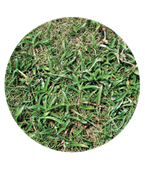The Problem
Annual bluegrass (Poa annua) is a winter annual and considered a weed in many turfgrass situations. However, it often is managed as a perennial and can be the desired species on golf courses throughout the northern United States. When annual bluegrass is managed as a perennial, the superintendent must manage seedhead production because it negatively affects playability of the putting surface. Additionally, a significant percentage of carbohydrates are diverted to seedhead production at the expense of other favorable processes within the plant. This leads to a weaker plant throughout the summer which is more susceptible to environmental stresses and pest damage. As a result, extra care must be taken in managing annual bluegrass to provide the necessary quality needed for putting green surfaces.
What To Look
For Annual bluegrass will begin to exhibit seedheads in the spring and may continue for weeks to months depending on location and weather. A secondary and much smaller seedhead flush may occur in the late summer or fall depending on geography. To effectively control seedheads, plant growth regulators (PGRs) must be applied before at the "boot" stage of development or earlier, which is prior to visible seedhead emergence. Research and practical experience over the last 10 years show that Proxy applied in the fall with the snow mold application or as growth slows in non-snowfall areas is highly effective at minimizing seedheads next spring when combined with traditionally timed spring applications.
The Solution
Ethephon, the active ingredient in Proxy®, is a PGR that helps reduce seedhead expression in annual bluegrass. After it is absorbed into the plant, it is converted to ethylene and disturbs the balance between the various plant hormones (ethylene, cytokinins, auxins, etc.). The increase in ethylene ratios to other hormones specifically helps to inhibit seedhead expression with limited effects on other plant functions. Here's some quick help to maximize suppression.
- Fall applications improve control: add a fall primer application with your snow mold application or near the final mowing for improved overall seedhead suppression the following spring
- Apply early in the spring: spring applications of Proxy without a previous fall application should be made as soon as the greens can withstand a sprayer to maximize seedhead suppression
- Why do fall applications work? Seedheads of annual bluegrass are initiated in the late fall and winter, even though they only become visible in the spring
- Tank mixes:
- Including Proxy in the snow mold application does not negatively affect seedhead or snow mold control the following spring
- Research indicates that applying products such as Signature™ XTRA Stressgard® or Fiata® Stressgard in the fall improve turf color and overall quality in early spring.
- Research also indicates that including Stressgard-containing products, such as Fiata, in spring applications is effective for reducing the yellowing that is sometimes observed when Proxy is applied alone
- Since Proxy reduces spray tank pH, it should be added last to tank mixes. The only exception is with Signature XTRA Stressgard, which should be added after Proxy
- Mountainous areas with a later summer seedhead flush:superintendents have had success applying Proxy in the late summer/early fall when daytime temperatures are consistently below 80°F. Consider combining with Stressgard-branded products to limit potential phytotoxicity
- Areas that do not go dormant in the winter: in areas of the Pacific Northwest or transition zone where cool-season grasses do not always go dormant, annual bluegrass seedhead production often begins in January and February. Best success is usually found with a fall application of Proxy when growth slows in November or December, followed by applications starting early the next year at 200 GDD32 (accumulation starting Jan 1), and then reapplications every 200-500 GDD32 until seedhead production ceases
Additional resources
| Solution sheet - Cool - Poa Annua | |
| Solution sheet - Warm - Poa Annua | |
| Solution sheet - Annual Bluegrass Seedhead |













